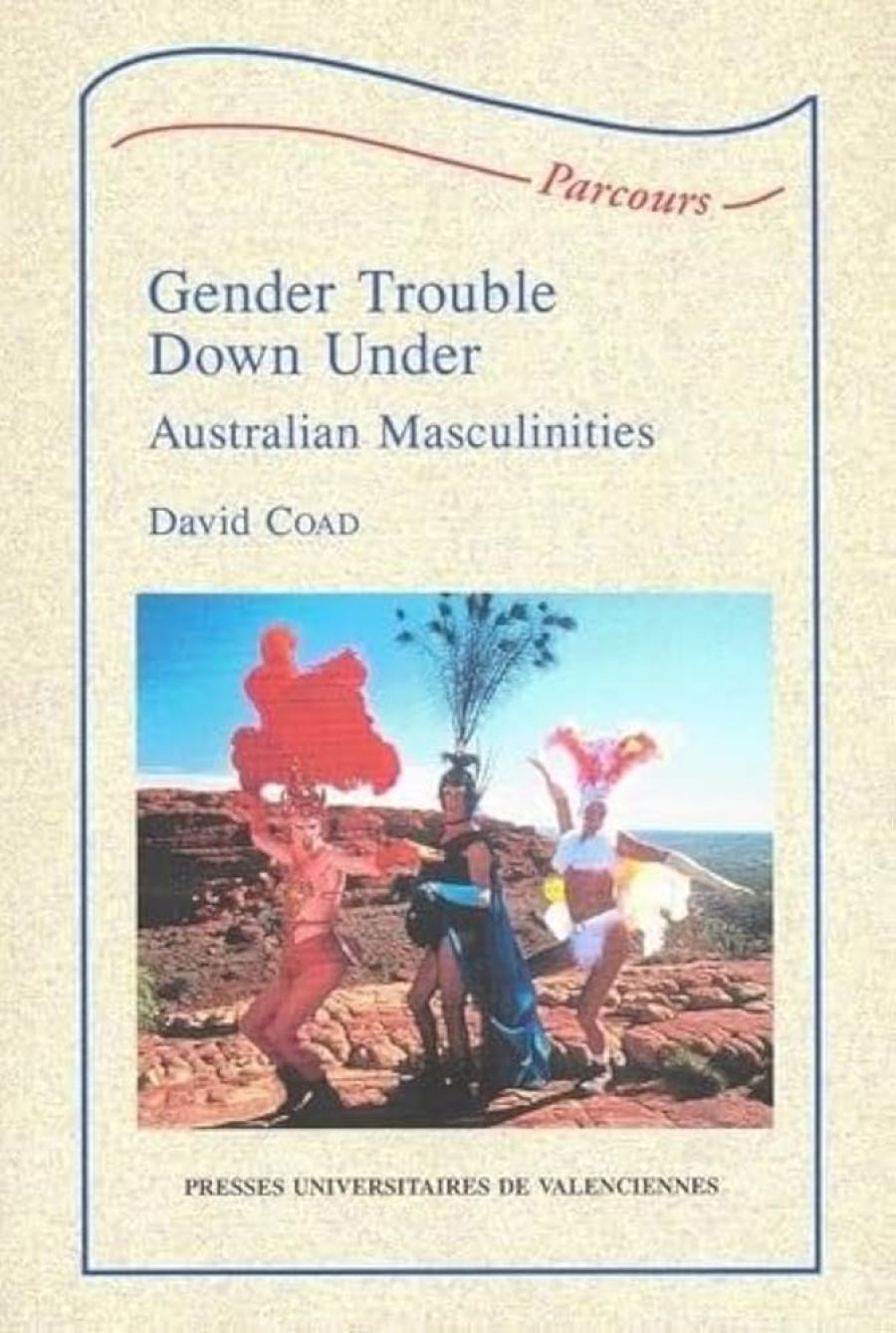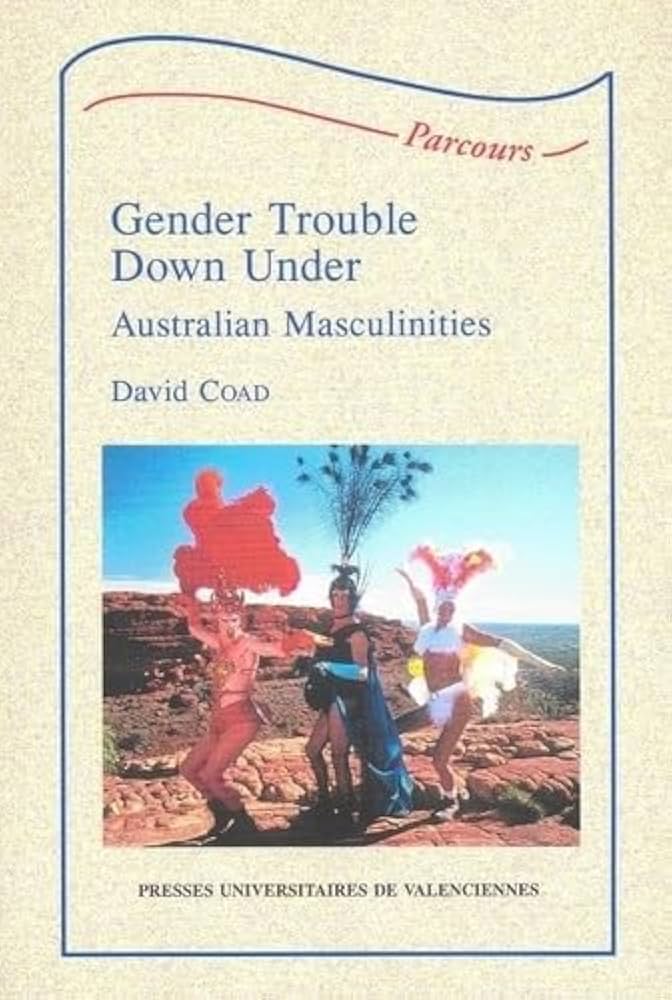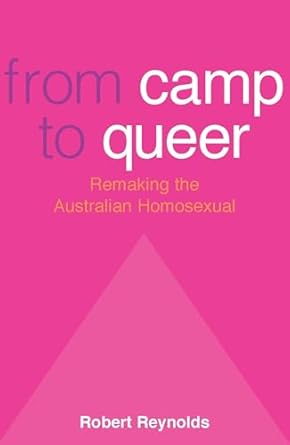
- Free Article: No
- Contents Category: Gay Studies
- Review Article: Yes
- Article Title: Eschewing Jouissance
- Online Only: No
- Custom Highlight Text:
I approached rom Camp to Queer with some trepidation. The author, Robert Reynolds, and I are roughly contemporary products of the same history department. The book itself covers much the same territory as the first few chapters of my Living Out Loud, but does so with a very different conceptual framework. This was compounded by a profile piece in a Melbourne gay paper, in which Reynolds was favourably contrasted with gay male academics like myself who look as though their gym membership cards disappeared down the back of the couch a few years ago.
- Book 1 Title: Gender Trouble Down Under
- Book 1 Subtitle: Australian masculinities
- Book 1 Biblio: Presses Universitaires de Valenciennes, $39.95pb, 199 pp
- Book 1 Cover Small (400 x 600):

- Book 1 Cover (800 x 1200):

- Book 2 Title: From Camp to Queer
- Book 2 Subtitle: Remaking the Australian homosexual
- Book 2 Biblio: MUP, $34.95pb, 207 pp
- Book 2 Cover Small (400 x 600):

- Book 2 Cover (800 x 1200):

I needn’t have worried. I like this book a great deal. Although called From Camp to Queer, it is really about the early years of the gay liberation movement in Australia -from 1970 to 1974. In that sense, From Camp to Gay would have been more accurate; the Epilogue on the rise of queer in the 1990s is pretty much an afterword.
The early 1970s was an extraordinary period when gay people set out to challenge the criminalisation, vilification and self-loathing that they had inherited – to remake themselves and the world. It is a story that has been told several times now, even in relation to Australia.
Reynolds’s contribution to our understanding of this work is via a panoply of theories: ‘cultural and psychoanalytic critiques of narcissism, Foucauldian theories of aesthetics and the self, a dash of poststructuralist theory, and the insights of psychoanalysts Melanie Klein and Donald Winnicott’, to quote his own succinct summary. Drawing upon all this, he argues that Gay Lib contained elements of both the modern and the postmodern. The modern is that Utopian yearning for revolutionary transcendence and the quest for the true self waiting to be discovered. Alongside these were the ways in which Gay Lib also gestured towards a postmodern politics - the eclectic, playful creation and recreation of self, and the disruptive, transgressive opening up of spaces within the present, which are, as we know, all that is possible.
Now, unreconstructed Marxist that I am, I don’t happen to believe this at all. The whole modern/postmodern binary seems to me to be deeply misconceived (as does the whole binary thing itself). But the virtue of Reynolds’s book is that he sets out his case clearly and concisely and, by and large, gives you what you need to make your own judgment. Not for Reynolds the armour of jargon. He even eschews the fashionable French, opting for ‘playfulness’, for example, over jouissance. And his descriptions of his theorists are refreshingly accessible.
What he doesn’t do enough is question his own foundations. His authorities are deployed against the liberationists. There are good, true theories (academics, mostly: Butler, Scott, Plummer, Winnicott) and bad, wrong theories (essentially anyone writing as a gay liberationist). How much more refreshing, even productive, if the theories had been deployed in some kind of mutual interrogation: if Gay Lib had been used to query postality and psychoanalysis, not just the other way round.
It is perhaps in the discussion of the politics of modernity and postmodernity that the weaknesses of that binary become clear. The liberationists were, for the most part, revolutionaries, seeking to overthrow the very categories of gender and sexuality as part of a broader assault on social, political and economic structures. Utopian transcendence, in Reynolds’s view. In a stimulating chapter, ‘Playing with Politics’, he describes the practices of the liberationists that he finds encouraging: the care of self and others; the attempt to rethink the way in which we live on a daily basis; play and irony in the streets. He is aware (as were the liberationists) of the danger in this - that it could narcissistically overlook the real constraints and suffering in the world - and notes (rather too casually for my liking) that there are difficulties in enacting a postmodern care of the self in a world that is so hostile to homosexuality. But, for Reynolds, the real importance of this politics is that it points to a recognition of a deeper truth -that, in a postmodern world, this is all that is possible.
Which is all very well, I suppose, except, as Reynolds notes, nothing much came of it. There was, for reasons he never quite explains, a turning away from the care of the self towards radicalisms of various kinds and towards liberalism. The absence of explanation here is startling. Like many of those he criticises - Marxists, even Sheila Jeffreys -Reynolds sees the development of gay politics in the mid1970s as a fall from grace, a failure to fulfil a potential so amply demonstrated; and, like them, he is at something of a loss to explain it. Perhaps this is the import of the Epilogue’s attention to the rise of queer, an attempt to persuade us (and himself) that postmodern politics did not fail (is not failing), but, rather, merely lost its way for a time.
As a history of Gay Lib, From Camp to Queer offers yet another perspective on a remarkable time. It offers a challenging study of how different tools, working the same materials, will generate quite different products. It is increasingly clear that the history of gay Australia is playing an important part in the discipline of history itself.
David Coad’s Gender Trouble Down Under is also concerned with Australia’s very queer history, but his is a broader canvas. He offers a survey of Australian masculinities since 1788, generally chronological, but, given its cultural studies approach, this neat narrative is constantly being disrupted. So the chapter that begins with the convicts lurches into antigay violence in the late twentieth century and youth suicide. Ned Kelly and his crossdressing sidekick Steve Hart jostle up against Chopper Read. Bush-women and their masculinity find themselves juggled with Dame Nellie Melba and Dykes on Bikes. It is all rather unsettling. It is, of course, meant to be.
Coad’s concern is with the paradox of an Australia that is both hypermasculine and homosocial, on the one hand, and the home of opera, dance and female impersonators, on the other. It is not a new problem, and the author draws upon the usual suspects to help him grapple with this: Foucault and Sedgwick and the rest of that gang are well represented. The book is published by the University of Valenciennes in France, where Coad lectures. It is part of a series on Australia. (They like us! They really like us!) Other volumes on literature, history, cinema and gender studies are noted. Written for an international audience, there are inevitably some problems, especially as Coad tries to translate Strine into English: ‘larrikin’ as ‘thug’ is just wrong; so too is ‘sheila’ as ‘young woman’. But his research is wide-ranging. He tells us that, in an early ballad, the reference to possum and kangaroo may well be a reference to homosexuality. He has the original newspaper source for the transvestism of Steve Hart. And his discussions of Edward De Lacy Evans, the female factories of Van Diemen’s Land, Errol Flynn and so on are likely to be new to many. The bibliography is a good starting point for students and researchers.
As an introduction to the history of Australian masculinity and its inherent queerness, and as a sampler in cultural studies, this book is ideal for students and those seeking material with which to teach them.


Comments powered by CComment